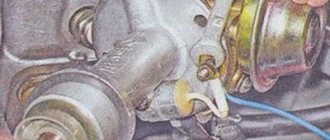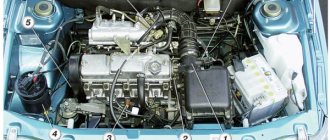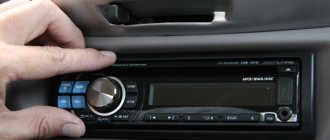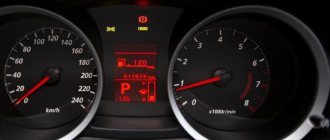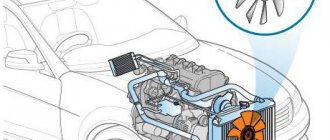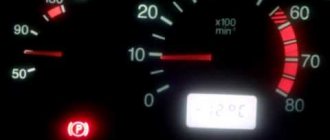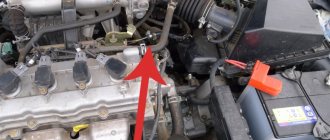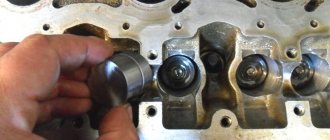When your car's oil level gets too low or the oil gets old, you may smell burnt oil in one of its many forms while behind the wheel. These smells indicate that your car needs an oil change and that it's time to schedule an appointment with your mechanic.
Where can the unpleasant smell of burnt oil come from in the cabin?
Typically, the smell of burnt oil enters the car interior through the air ducts of the ventilation system, the entrance to which is located above the engine compartment. It is most clearly felt after the engine has warmed up, with the cabin fan turned on and the recirculation mode turned off. Odor can also come through:
The main reasons for the appearance of odor in the cabin: video
- pedal assembly;
- central tunnel in the area of the gearshift lever drive;
- door seals;
- slightly open windows.
The persistent smell of burnt oil in the cabin clearly indicates a technical malfunction of the engine , less often the transmission and attachments. Their sources are usually localized in the engine compartment, so you can smell the burning smell by looking under the hood after the engine has warmed up.
The smell of burnt oil in the vehicle interior can come from the exhaust system or components of the transmission and all-wheel drive system located under the interior floor. If you don’t feel it when you open the hood, you should look for the problem in a pit, overpass or lift.
Smell from heater or air conditioner fan
Check for debris inside the stove. If you haven't used the stove for a long time, dust may have accumulated. But if the burning smell still appears in the car even after using the heater regularly, then there may be some debris in the vent.
People often find plastic bags or other items stuck in the engine, which can cause a burning smell. However, it is possible that the heater itself is damaged and antifreeze is leaking into the vents. It may also cause an odor. To make matters worse, part of the heater may be broken or melted. If the smell gets stronger and you don't find any debris stuck on the fan, head to a garage immediately.
Why does the cabin smell like burnt oil?
Repeated occurrences of a persistent burning smell in the cabin are a sign that the lubricant is getting on the hot walls of the cylinder block, the exhaust system and/or adjacent components. Most often this is due to engine problems . The most likely reasons why an oil smell may appear in the cabin are listed in the table:
| Probable Cause | Characteristic signs | Cause of the problem |
| Wear of oil seals | Oil leaks in the crankshaft area, most often from the timing drive side. | High oil level, increased crankcase gas pressure. |
| Wear of oil scraper rings | Oily spark plugs, blue smoke and oil smell from the exhaust pipe. | Untimely oil change, engine overheating, natural wear of the CPG. |
| Clogged or depressurized breather | Oil leaks in the area of the pipe or valve cover gasket, cracking of the hose. | Irregular cleaning of the breather, excessive oil runs. |
| Low oil volume in the crankcase | The “oil can” indicator is on or the oil level on the dipstick is low. | Lack of oil, leak, burnout in the engine. |
| Leaking valve cover or cylinder head gaskets | Oil leaks between the cover and the cylinder head or between the head and the cylinder block. | Worn or incorrectly installed gaskets. |
| Crankcase gas outlet | Oiling in the area of the pipe and hose, breather, oil filler neck, valve cover. | Clogged ventilation system, worn piston rings. |
| Oil leak through turbine | Oil contamination of the throttle valve and intake manifold or blue smoke and oil smell from the exhaust pipe, increased oil consumption. | Clogged air filter, oil line, oil overflow, turbine malfunction. |
| Transmission problem | Leakage through the gearbox input shaft oil seal, deterioration of the clutch, leaks at the junction of the gearbox housing and the engine. | Use of unsuitable oil, wear of seals. |
| Oil getting into the power unit housing | Traces of oil on the cylinder block, mainly around the oil filler neck and dipstick hole. | Oil spilled during replacement/checking, the oil filler cap was unscrewed, the dipstick seal was worn. |
As a rule, the smell resulting from oil leaks intensifies when the engine warms up, as the oil begins to burn out. If oil gets into the exhaust system, symptoms appear almost immediately after starting the engine. During rain or snowfall, the cause of a temporary odor may be the ingress of moisture with oil particles or reagents from the road surface onto the exhaust pipe.
Transmission
Problems with the box can result in more serious costs, especially if you do not pay attention to it in time. Here, problems and their solutions will be divided into malfunctions with manual and automatic transmissions.
Manual transmission
In diagnostics, everything is extremely simple here; you just need to inspect the transmission. If there is a leak, you will see an oil stain that cannot be confused with anything. The reason may be that the bearing is worn out, and oil begins to get onto the clutch. The solution is simple, change the bearing, and the cost will depend on the make and model of the car.
How to determine the cause of the smell of burnt oil in the car interior
To determine the cause of the smell of burnt oil in the car, you first need to localize its source. In most cases, the smell spreads:
How to determine the cause of the smell of burnt oil in the cabin: video
- from the engine compartment;
- from under the car;
- from the exhaust pipe.
Indirect signs will help you determine the exact location in advance. If you smell burnt oil when driving with the windows open, the smell appears or intensifies when you turn on the interior ventilation system and disappears some time after turning on the recirculation mode - most likely it comes from the engine compartment. The appearance of odor when the windows are open while parked and its absence when driving indicates that the source is located under the bottom . When oil is released directly through the exhaust system, in addition to the smell, blue smoke . A visual inspection will allow you to reliably determine the source.
If maintenance has recently been carried out, including changing the oil, adjusting valves, replacing oil seals and cylinder head gaskets, valve covers, and exhaust manifolds, first of all you should inspect the components that were repaired and serviced for oil traces.
Oil smell from engine compartment
The main reasons for the smell of oil from the engine compartment:
Oil leaking from under the cylinder head cover
- Oil that gets onto the engine or gearbox when adding or replacing it.
- Leaking valve cover and cylinder head gaskets.
- Leaking crankshaft and camshaft seals.
- Clogged or damaged pipe of the crankcase ventilation system (breather).
More precisely, the source of the smell is determined by visual inspection of the engine compartment for traces of oiling. To check the condition of the crankshaft and camshaft seals, it is necessary to remove the timing cover.
A leak from under the valve cover gasket can be eliminated by tightening the cover fasteners without exceeding the permissible torque. If this does not help, the gasket needs to be replaced. If the cylinder head gasket is leaking, leakage of not only oil, but also coolant , including their mixing in the cooling system and cylinder block. This malfunction is indicated by the smell of coolant and white smoke from the exhaust, the presence of oil stains in the antifreeze and a change in its level in the expansion tank. A broken gasket must be replaced immediately.
Oil leak from crankshaft seal
If you find oil around the breather hose , remove it, wash the hose itself and the oil separator filter, and then inspect it. If there are cracks in the pipe, it must be replaced. A stuck breather valve also requires replacement. The release of a significant amount of oil through the breather may be a sign of wear on the elements of the cylinder-piston group , a clogged air filter, a clogged oil deflector drain, or an increased oil level in the engine.
leaks from under the crankshaft and camshaft seals indicate an increased oil level , increased pressure in the cylinder block, for example, due to clogging of the crankcase ventilation system, or wear of the seals themselves. If the oil level is normal, the breather is not clogged and there are no signs of excess pressure (when you open the oil filler cap, no smoke comes out, the cap does not fly out when unscrewed), the seals need to be replaced.
After eliminating the causes of the leak and in the event that the smell of burnt oil in the car interior appears as a result of a spill, it is necessary to remove all smudges in the engine compartment using a rag and brake cleaner.
Oil smell from the bottom of the car
Oil leak from engine to exhaust
If the smell of burnt oil penetrates from the bottom after or during driving, inspecting the car on a pit or a lift will help.
Oiling of the engine oil pan may be a result of a leaking gasket, insufficient tightening of the drain plug, or deformation of the o-ring. To eliminate the cause, worn parts must be replaced.
Oil marks at the junction of the engine and gearbox indicate oil leakage through the gearbox input shaft oil seal or the rear crankshaft oil seal. The exact cause can only be determined when the gearbox is removed, but first, pay attention to a number of features that can lead to a preliminary conclusion.
Indirectly, transmission oil is distinguished from motor oil by the following characteristics:
Oil leakage at the junction of the engine and gearbox
- Gear oil has a strong sulfur odor and is darker in color.
- If you bring oil-stained fingers together and then spread them apart, the film from the transmission oil will break immediately, but not from the engine oil.
- Dissolve a drop of oil in water - the appearance of a thin iridescent film indicates a transmission leak.
A strong smell of burnt oil after driving a car with an automatic transmission indicates burning of the friction linings, which, in turn, is a sign of a low level or insufficient transmission oil pressure, or other problems in the automatic transmission.
The reason for the periodic appearance of the smell of burnt oil from the bottom may be oil from the road surface getting into the exhaust system. Most often this happens in rainy weather or when there is snow on the road.
In vehicles with all-wheel drive, you should also check the transfer case and gearbox housing for leaks. Oil may leak from them due to worn seals that need to be replaced.
Burning smell in the exhaust
Blue smoke from the chimney is a sign of serious problems
If you smell burnt oil when driving or parking, but you do not find any leaks in the engine compartment or under the bottom, take a closer look at the exhaust.
Smells, traces of oil, and blue smoke from the exhaust pipe are signs of serious problems.
The cause may be severe wear of the CPG, stuck piston rings, worn valve stem seals, and in turbocharged cars also problems with the turbine. To eliminate the cause, a comprehensive engine diagnostics is required.
Ozonation
When bacteria and microorganisms have permeated the upholstery, these odors can only be removed from the vehicle using such an effective technology as ozonation. Today, this service, which can be obtained at a car service center, is gaining increasing popularity (despite its relative high cost).
What is the principle of this procedure? Ozone, which is a powerful oxidizing agent, is able to penetrate into the thickness of almost any material and fight both bacteria and fungi, as well as mold.
On a note! Unlike many methods that only mask the smell and make it more “light,” this method differs in that it allows you to completely remove it.
The procedure is performed as follows:
- An oxygen cylinder (that is, an ozone generator) is placed in the cabin.
- Turn on the ventilation system in recirculation mode.
- After 20 minutes, the ventilation is turned off, and the ozone generator continues to operate for 15 minutes.
- The vehicle is ventilated and the interior is wet cleaned.
On a note! The smell of ozone remains in the car for some time after the procedure, but it has a rather pleasant aroma and does not pose any threat to the health of not only people, but also animals.
Noise when disengaging clutch
The presence of a powerful hum when the clutch is disengaged also indicates a problem with the clutch; the driver should immediately resort to the services of a service station.
The use of a damaged device can cause a sudden breakdown of the car or emergency conditions on the road.
In addition, savings on simple services can lead to the most significant expenses in the future.
Folk remedies to combat odors
We offer simple ways to get rid of the unpleasant “orange”:
- Apply a few drops of such a strong flavor as vanilla extract to the seat upholstery.
- We divide the vanilla pods in half, place the contents of each half on a cotton swab and place them somewhere in the salon. This flavoring agent is effective for 7-8 days.
Important! You should not use synthetic vanilla: it is of no use.
- Place the coffee grounds in a container and leave, for example, on the front panel overnight. In the morning we ventilate the interior.
- Mix ground cinnamon with apple cider vinegar to form a thick paste. Place the resulting mixture in a plastic container (necessarily with a lid), in which holes are made on top. We put all this in the car interior, for example, under the driver’s seat, and enjoy the aromas.
- Place dried, crushed citrus peels at the bottom of a canvas bag and hang them somewhere in the cabin. Women will appreciate this fragrance.
- Take a large green apple, cut out the core and leave the fruit in the cabin until it dries completely. Then it acts as an adsorbent.
- Coffee beans can also help combat odors. Unlike coffee grounds, they “like” sunlight. The grains can be placed in canvas bags, in containers or simply on a sheet of paper.
Important! The presence of a pleasant aroma in the car interior is, of course, very important, but we should not forget that not all of them contribute to driver concentration. Remember: the smell of fresh baked goods or grass, as well as flowers, can lead to inattention, and this is fraught with serious consequences on the road.
Wheel slipping
In order to establish the reliability of the clutch, it is possible to carry out a simple test.
- The driver needs to accelerate at a low speed, 60 - 70 km/h, and also check whether the car’s wheels are slipping.
- If this happens, it means that the system is operating incorrectly. In addition, the correct indicator of a malfunction is considered to be a very slow process of driving the car, when the engine is running at full power.
Wheel slipping can also occur while the pedal is pressed. This can cause destruction of the disks, as well as burning of the electrode pads.
Brakes
The brake mechanisms of wheels that have begun to jam due to problems with the hydraulic or cable drive can heat up to such an extent that the smell of overheated oil and metal will be felt in the cabin. At the same time, smoke may even billow from the wheel hubs. True, this is unlikely to cause a fire, but the trip will still need to be interrupted and technical assistance called. As a result, service station employees will unlock the wheels by reducing the pressure in the hydraulic drive or loosening the handbrake cable, after which they will pull the car onto a tow truck for further manipulation.


